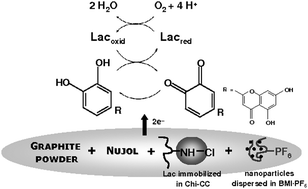Biosensor for luteolin based on silver or gold nanoparticles in ionic liquid and laccase immobilized in chitosan modified with cyanuric chloride
Abstract
Novel and effective biosensors based on Ag or Au

* Corresponding authors
a
Departamento de Química, Laboratório de Biossensores, Universidade Federal de Santa Catarina, Florianópolis, Santa Catarina, Brazil
E-mail:
aninhafranzoi@yahoo.com.br
b Departamento de Química Orgânica, Laboratório de Catálise Molecular, Universidade Federal do Rio Grande do Sul, Porto Alegre, Rio Grande do Sul, Brazil
Novel and effective biosensors based on Ag or Au

 Please wait while we load your content...
Something went wrong. Try again?
Please wait while we load your content...
Something went wrong. Try again?
A. C. Franzoi, I. C. Vieira, J. Dupont, C. W. Scheeren and L. F. de Oliveira, Analyst, 2009, 134, 2320 DOI: 10.1039/B911952C
To request permission to reproduce material from this article, please go to the Copyright Clearance Center request page.
If you are an author contributing to an RSC publication, you do not need to request permission provided correct acknowledgement is given.
If you are the author of this article, you do not need to request permission to reproduce figures and diagrams provided correct acknowledgement is given. If you want to reproduce the whole article in a third-party publication (excluding your thesis/dissertation for which permission is not required) please go to the Copyright Clearance Center request page.
Read more about how to correctly acknowledge RSC content.
 Fetching data from CrossRef.
Fetching data from CrossRef.
This may take some time to load.
Loading related content
